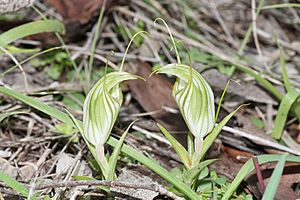Sharp-leaf greenhood facts for kids
Quick facts for kids Sharp-leaf greenhood |
|
|---|---|
 |
|
| Pterostylis robusta growing near Charlton | |
| Scientific classification | |
| Genus: |
Pterostylis
|
| Species: |
robusta
|
| Synonyms | |
|
|
The Pterostylis robusta, also known as the sharp-leaf greenhood, is a special type of orchid. It grows only in south-eastern Australia, meaning it is endemic to that area. Like many orchids, this plant looks different depending on whether it is flowering or not.
When the sharp-leaf greenhood is not flowering, it has a group of leaves that grow in a circle close to the ground. This is called a rosette. But when it's ready to bloom, a single flower grows on a tall stem, and the leaves move up onto that stem. This greenhood has a fairly large flower that is green, white, and reddish-brown. It often has reddish-brown stripes. A small part of its lip, called the labellum, can be seen inside the flower.
What it Looks Like
The sharp-leaf greenhood (Pterostylis robusta) is a plant that grows from the ground. It is a perennial, which means it lives for more than two years. It's also a deciduous plant, meaning some parts die back each year, usually in winter. It's a type of herb that grows from an underground storage part called a tuber.
When the plant is not flowering, it has a rosette of four to ten dark green, egg-shaped leaves. Each leaf is about 10–25 millimeters (less than an inch) long and 10–16 millimeters wide.
Flowering plants have one flower. This flower is about 27–35 millimeters long and 10–12 millimeters wide. It grows on a stem that is 50–200 millimeters (about 2 to 8 inches) tall. This stem also has three to seven spreading leaves. The flowers are a mix of green, white, and brownish colors, often with a reddish-brown tint or stripes.
The top part of the flower, called the dorsal sepal, and the petals are joined together. They form a hood, or "galea," over the central part of the flower, which is called the column. The dorsal sepal curves forward and has a sharp point at the end, about 2–4 millimeters long. The side parts of the flower, called the lateral sepals, stand upright and stay close to the hood. They have a thin, thread-like tip that is 20–30 millimeters long. Between their bases, there's a flat dip with a small notch.
The labellum, or lip, of the flower is 12–15 millimeters long and 3–4 millimeters wide. It is dark brown or green and is just barely visible inside the flower. These orchids usually bloom from April to August.
How it Got its Name
The sharp-leaf greenhood was officially described for the first time in 1927. This was done by a scientist named Richard Sanders Rogers. His description was published in a scientific journal called Transactions and Proceedings of the Royal Society of South Australia.
The second part of its scientific name, robusta, comes from a Latin word. It means "strong like oak" or "robust," which suggests the plant is sturdy.
Where it Grows
The sharp-leaf greenhood is most commonly found in areas of South Australia that get a lot of rain. In these places, it can sometimes grow in very large groups, forming big colonies.
In Victoria, this orchid grows in open forests in the north-west part of the state. It is quite rare in New South Wales. There, it grows on sheltered hillsides south of Wagga Wagga.

